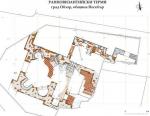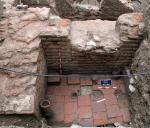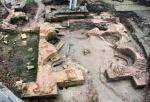Summary (English)
TEMPLUM IOVIS (Todor Marvakov – tmarvakov@abv.bg, Konstantin Gospodinov, Martin Giuzelev) The explorations of the Early Byzantine thermae continued. Room No. 1 was a frigidarium. Its southern wall was discovered, built of bricks, 32 cm by 32 cm by 6 cm in size, bonded with mortar. There were three U-like exedrae within the wall, one of them with preserved part of a marble veneer. The earliest lowest floor was paved with stone slabs arranged over a layer of stones covered with mortar. The next upper floor was paved with bricks arranged over a mortar layer. The latest uppermost floor was paved with marble tiles arranged over a mortar layer. There was an anteroom with two entrances towards Rooms Nos. 2 and 4, located in the eastern end of Room No. 1. Room No. 2 was a caldarium. It was built of bricks bonded with mortar. Holes in the mortar of the joints between the bricks were documented. The holes accommodated metal hooks which held terracotta tubi from the wall heating. Fragments from tubi were found in the room. Several vertical terracotta pipes from the hypocaust, which supported the floor, were discovered. Part of a kiln that heated the building was explored. Part of it was situated under Room No. 2. Room No. 3 was a service room. Room No. 4 was a tepidarium. The bottom of the hypocaust was paved with bricks arranged over a mortar layer. Parts of four vertical terracotta pipes and two columns of bricks that supported the floor were preserved. The finds from the excavations included sherds from Late Antique amphorae and pots and 20 coins from Zeno to Justin II. The thermae dated from the middle of the 5th to the end of the 6th centuries AD.
- Todor Marvakov - ‘Old Nesebar’ Museum
- Konstantin Gospodinov - Archaeological Museum – Burgas
- Martin Giuzelev - Archaeological Museum – Burgas
Director
Team
Research Body
- Archaeological Museum – Burgas
- ‘Old Nesebar’ Museum






![Download [PDF]](/excavation/skins/fasti/images/results/download_sml.png)

